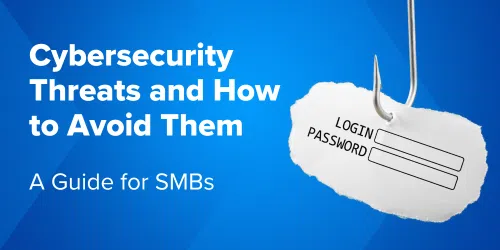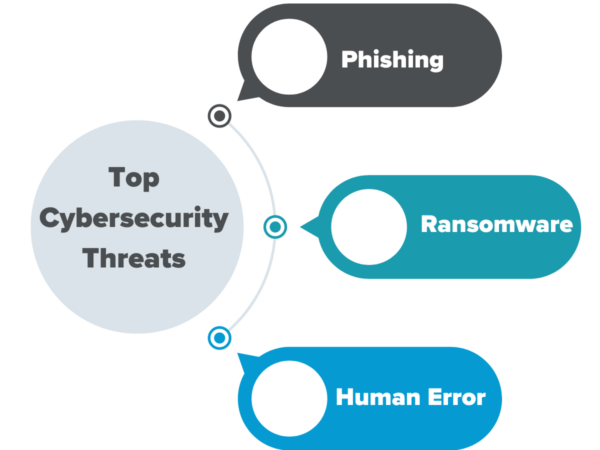Cybersecurity Threats and How to Avoid Them: A Guide for SMBs

Imagine arriving at your office, ready to start the day, only to find that your entire system is locked down and held hostage by a faceless cybercriminal demanding a ransom. This scenario plays out in businesses of all sizes every day. These cybersecurity threats are all too real for small and mid-sized businesses (SMBs) that rely on Sage business management solutions including Sage 100. And the stakes have never been higher. Here we explore cybersecurity threats and how to avoid them.
The Illusion of Immunity: Why Small Businesses Are Prime Targets
Many SMBs operate under the false assumption that they’re too small to be targeted by cybercriminals. “Why would anyone bother with us?” they think. This misconception makes them attractive targets. Hackers know that smaller companies often lack the robust defenses of larger enterprises, making them easy prey for cyber attacks, including methods like guessing, brute force, and deception to compromise user passwords.
2023 was especially brutal for SMBs, with over 60% experiencing a cyberattack. After a malware attack the average downtime is 21 days, and many companies cannot recover from the damage, shutting down within six months. These aren’t just statistics—they are the grim realities faced by businesses that thought they were too small to be targeted.
Watch the on-demand webinar: Tales from the Cyber Crypt—Smart Solutions for Business Defense
What are Cyber Threats?
Cyber threats encompass any malicious activity targeting computer systems, networks, or data. These threats can manifest in numerous forms, including malware attacks, phishing scams, ransomware attacks, social engineering tactics, and advanced persistent threats (APTs). For instance, malware attacks involve malicious software designed to infiltrate and damage computer systems. On the other hand, phishing scams trick individuals into revealing sensitive information. Individuals, organized groups, or even nation-states can orchestrate cyber threats, each with their own motives and methods. The consequences of these cyber threats can be severe, ranging from financial losses and reputational damage to compromised national security.
The Rising Tide of Cyber Threats and Data Breaches
Cyber threats are constantly evolving, with new risks emerging at an alarming rate. Three of the most prevalent and damaging threats are phishing, ransomware, and human error.

Phishing Attacks — The Trojan Horse of Cybercrime
Phishing is the most common entry point for cybercriminals and is a form of social engineering attacks. A fraudulent email masquerades as legitimate communication, tricking the recipient into clicking a malicious link or downloading an infected attachment. Once that link is clicked, it’s game over.
For example, Ubiquiti Networks, a major provider of networking devices, fell victim to a phishing attack in 2021. Cybercriminals used a phishing email to trick employees into transferring $46.7 million to fraudulent overseas accounts. Although Ubiquiti eventually recovered some funds, the incident is a stark reminder of how easily even well-established companies can be duped.
For smaller businesses, the risk is even greater. A single phishing email can lead to a data breach, exposing sensitive information and crippling operations. With nearly 90% of successful breaches starting with a phishing email, it’s clear that no one is immune.
Ransomware — Modern-Day Kidnapping
Ransomware attacks have surged, becoming a favored tool for cybercriminals. These attacks lock users out of their systems or encrypt their data until a ransom is paid. Attackers often gain unauthorized access by exploiting vulnerabilities, leading to severe consequences like data breaches or malicious attacks. And they’re not just targeting large corporations—SMBs are frequently in the crosshairs.
In 2021, Colonial Pipeline, a major fuel supplier, was hit by a ransomware attack that forced the company to shut down operations, leading to fuel shortages across the Eastern United States. The attackers demanded—and received—a $4.4 million ransom. While Colonial Pipeline was able to resume operations, the incident underscores the devastating impact ransomware can have, even on critical infrastructure.
For SMBs, the costs of a ransomware attack extend beyond the ransom itself. There’s lost revenue, reputational damage, and the expense of restoring data and systems. The disruption to business operations can be catastrophic for smaller companies.
Human Error — The Weakest Link in Cybersecurity
Even the most advanced security systems can be undone by human error. Whether it’s using weak passwords, mishandling sensitive data, or simply not recognizing a phishing attempt, employees can unintentionally open the door to attackers who aim to steal data.
For example, in June 2022, Pegasus Airlines discovered an error in the configuration of one of its databases, exposing 6.5 terabytes of the company’s valuable data. An airline employee had misconfigured security settings, making 23 million files with flight charts, navigation materials, and crew personal information available for the public to see and modify.
The incident highlights the critical role that human factors play in cybersecurity threats. Despite rigorous training and security protocols, the human element remains a significant vulnerability. For SMBs, where resources for training and oversight may be limited, the risk is even greater.
Network and Application Attacks
Network and application attacks are specific types of cyber threats that target the core of an organization’s IT infrastructure. These attacks can take various forms, such as distributed denial of service (DDoS) attacks, which overwhelm a system with traffic, causing it to crash. Man-in-the-middle (MitM) attacks intercept and alter communications between two parties without their knowledge, while injection attacks exploit vulnerabilities in applications to execute malicious code. The impact of these network and application attacks can be devastating, leading to system downtime, data breaches, and significant reputational damage. For SMBs, the consequences can be particularly dire, as they may lack the resources to recover quickly from such incidents.
Why Cybersecurity is Such a Daunting Challenge
Given the frequency and severity of these threats, why are cybersecurity threats still such a daunting challenge for SMBs? The answer lies in the complexity of the problem.
The Evolving Nature of Cybersecurity Threats
Cyber threats are not static—they evolve. Hackers constantly develop new techniques to bypass defenses, exploiting vulnerabilities that didn’t exist yesterday. For example, phishing attacks have become more sophisticated, with cybercriminals using deep fake technology to mimic the voices of executives in business email compromise (BEC) schemes.
The rapid pace of innovation in the cybercrime world means that security measures must be continuously updated. What worked to protect your business last month may be inadequate today, requiring constant vigilance and adaptation.
The Complexity of IT Environments
As SMBs adopt more digital tools and platforms, their IT environments become more complex. Each new tool introduces potential vulnerabilities, creating more opportunities for cybercriminals to exploit. Cloud computing, while offering numerous benefits, adds another layer of complexity. Managing these environments requires a level of expertise that many SMBs simply don’t have.
Resource Constraints
Cybersecurity isn’t just about technology—it’s about people. SMBs often lack the resources, both financial and human, to implement comprehensive cybersecurity measures. Hiring cybersecurity experts, maintaining up-to-date defenses, and ensuring continuous monitoring are costly endeavors. These expenses can seem prohibitive for many SMBs already operating with tight budgets.
Regulatory Challenges
Navigating the complex web of cybersecurity regulations adds another layer of difficulty. SMBs are often required to comply with various standards, depending on their industry and geographic location, and must also be vigilant against sophisticated threats like supply chain attacks. Non-compliance can result in hefty fines and legal repercussions. However, staying compliant requires a significant investment in time, expertise, and technology—resources that many SMBs struggle to allocate.
Protecting Sensitive Data
Protecting sensitive data is a critical aspect of cybersecurity for any organization. Sensitive data includes personally identifiable information (PII), financial data, intellectual property, and confidential business information. The loss or compromise of this data can have severe consequences, including financial losses, legal repercussions, and damage to an organization’s reputation. Therefore, implementing robust security measures to protect sensitive data from unauthorized access, theft, or compromise is essential.
Securing Sensitive Data in the Cloud
Securing data in the cloud requires a comprehensive approach that includes robust security controls, encryption, and access management. Organizations must ensure that their cloud service providers (CSPs) have implemented adequate security measures to protect sensitive data. This includes regular security audits, penetration testing, and compliance with relevant regulations such as GDPR and CCPA. Additionally, organizations must educate their employees on cloud security best practices and ensure they understand the risks associated with storing sensitive data in the cloud. By taking these steps, businesses can significantly reduce the risk of data breaches and ensure that their sensitive information remains secure.
A Path Forward — Cloud Hosting Solutions for Business Defense
How can SMBs navigate this complex landscape? The key lies in adopting a smart, comprehensive approach to avoiding cybersecurity threats—one that addresses both the technological and human elements of the problem.
Our Sage hosting partner, Cloud at Work, understands the unique challenges faced by SMBs. Their virtual private cloud hosting solutions are designed with security at the forefront, providing a fortified environment for your Sage applications. They offer advanced email security that filters out phishing attempts, robust ransomware defenses, and continuous monitoring to ensure your systems are always protected.
But technology alone isn’t enough. They also empower your team with the knowledge and tools they need to recognize and respond to threats. By building a culture of cybersecurity awareness, Cloud at Work helps you turn your employees from potential vulnerabilities into your first line of defense. Cybersecurity is a complex, ever-evolving challenge, but it’s one you can meet with the right approach.
Why Partner with Cloud at Work Hosting Provider
We partner with Cloud at Work as our Cloud Service Provider (CSP) because they are top Sage 100 cloud hosting provider in North America, equipped with deep understanding and management skills for such intricate systems. Moreover, they remove the complexities commonly associated with hosting and make it simple for our clients to make the transition and begin realizing the benefits.
Cloud at Work can help safeguard your business and vital Sage applications in this complex threat landscape. Ready to talk to us about moving your Sage 100 system to a cloud environment?




